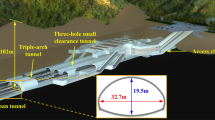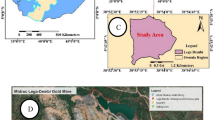Abstract
The investigation of the effect of resultant stress and stress distributions on the tunnel itself and the aboveground constructions due to underground mining activities (tunnelling, gallery excavation, etc.) in shallow depths (less than 50 m) and weak rock zones near residential areas is a significant and essential procedure. The poses of risk in aboveground constructions due to the tunnel construction in shallow depths and weak rock zones are emphasized in this study. The data calculated by empirical methods (subsidence, number of stability, angular distortion, etc.) are compared to the results of measurements and observations to be evaluated. Besides, the results of calculations and laboratory studies are evaluated on a numerical model by creating what-if scenarios and solutions. The necessity of careful observation of aboveground constructions, inspection of the projects simultaneously with empirical, analytical and numerical methods is revealed as the result of the study.









Similar content being viewed by others
References
Abdollahipour A, Rahmannejad R (2013) Investigating the effects of lateral stress to vertical stress ratios and caverns shape on the cavern stability and sidewall displacements. Arab J Geosci 6:4811–4819
Amadei B, Stephansson O (1997) Rock stress and its measurement. Chapman and Hall, London
Arıoğlu B, Yüksel A, Arıoğlu E (2002) Geotechnical studies and evaluation in Nenehatun Tunnel on Izmir Metro Project, in proceedings of symposium on structural and earthquake engineering, Ankara. pp.1–11
Attewell PB, Yeates J, Selby AR (1986) Soil movements induced by tunnelling and their effects on pipelines and structures. Blackie and Son, London
Benardos AG, Kaliampakos DC (2005) Hydrocarbon storage in unlined rock caverns in Greek limestone. Tunn Undergr SpaceTechnol 20:175–182
Carranza-Torres C, Fairhurst C (1999a) The elasto-plastic response of underground excavations in rock masses that satisfy the Hoek– Brown failure criterion. Int J Rock Mech Min 36:777–809
Carranza-Torres C, Fairhurst C (1999b) Elasto-plastic analysis of elliptical cavities in rock subject to non-hydrostatic loading, in FLAC and numerical modeling in geomechanics. In: Detournay C, Hart R (eds) Proceedings of the Conference, Minneapolis, September 1999. Balkema, Rotterdam, pp 215 – 223
Chryssanthakis P, Barton N (1995) Dynamic loading of physical and numerical models of very large underground openings. In: Pro-ceedings of the 8th International Conference on Rock Mechanics, Tokyo. 3, pp 1313–1316
Fan SC et al (2004) On modeling of incident boundary for wave propagation in jointed rock masses using discrete element method. Comput Geotech 31(1):57–66
Hao YH, Azzam R (2005) The plastic zones and displacements around underground openings in rock masses containing a fault. Tunn Undergr Space Technol 20:49–61
Hoek E, Brown ET (1980a) Underground excavations in rock. Institution of Mining and Metallurgy, London
Hoek E, Brown ET (1980b) Empirical strength criterion for rock masses. J Geotech Eng Div 106:1013–1035
Kun M (2010) Investigation and solution of tunnel boring design and construction requirements in weak rocks and faulted zones. Ph.D. thesis (In turkish), Dokuz Eylul Universtity The Graduate School of Natural and Applied Sciences, Izmir, Turkey
Kun M, Onargan T (2013) Influence of the fault zone in shallow tunneling: a case study of Izmir metro tunnel. Tunn Undergr Space Technol 33:34–45
Migliazza M, Chiorboli M, Giani GP (2009) Comparison of analytical method 3D finite element model with experimental subsidence measurements resulting from the extension of the Milan underground. Comput Geotech 36:113–124
Onargan T, Aksoy CO, Güngör T, Küçük K, Kun M (2006) The evaluation of excavation and support system between Göztepe and F.Altay stations of 2nd stage of Izmir Metro Project, (in Turkish) Izmir, Turkey. DEUEF project report
Ramamurthy T, et al (1995) Stability of underground opening from equivalent material modeling. In:Proceedings of the 8th International Conference on Rock Mechanics, Tokyo. 3, pp. 1363–136
Rocscience Inc. (2006) Phase v6 softvare, Canada
Schubert W, Steındorfer A (1996) Selective displacement monitoring during tunnel excavation. Felsbau 14:93–97
Stephansson O (1993) Rock stress in the Fennoscandian shield. Comprehensive Rock Engineering, Pergamon Press, Oxford, Chapter 17, Vol 3, pp. 445–59
Töyrä J (2006) Behaviour and stability of shallow underground constructions. Ph.D. thesis, Luleå University of Technology Department of Civil and Environmental Engineering Division of Mining and Geotechnical Engineering, Luleå, Sweden
Yujing J et al (2009) Simulation of cracking near a large underground cavern in a discontinuous rock mass using the expanded distinct element method. Int J Rock Mech Min 46:97–106
Author information
Authors and Affiliations
Corresponding author
Rights and permissions
About this article
Cite this article
Kun, M. The effect of shallow depth tunnelling on aboveground constructions. Arab J Geosci 8, 5247–5256 (2015). https://doi.org/10.1007/s12517-014-1507-7
Received:
Accepted:
Published:
Issue Date:
DOI: https://doi.org/10.1007/s12517-014-1507-7




